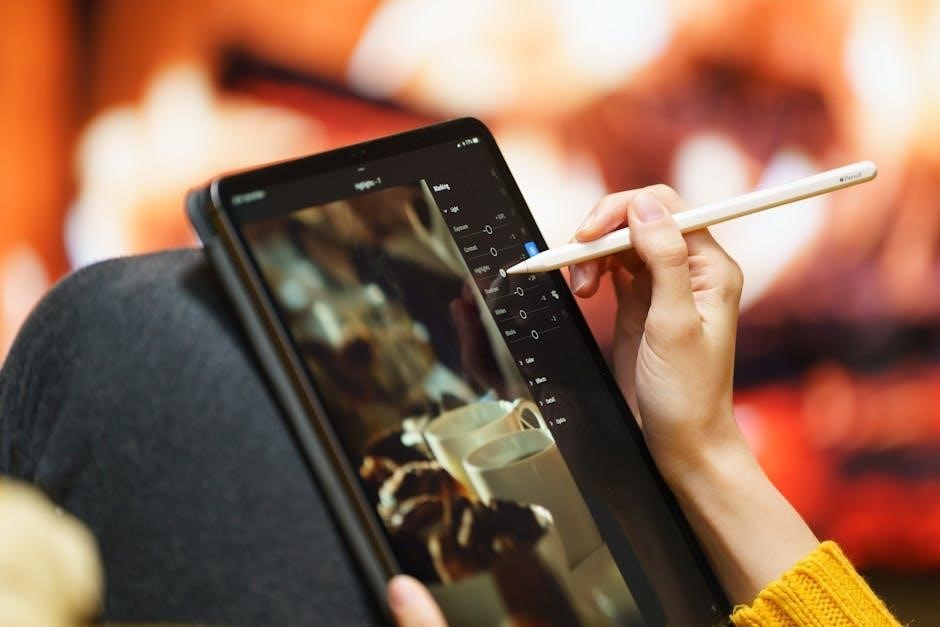VCarve Pro Tutorials: A Comprehensive Guide
Your Ultimate Resource for Mastering VCarve Pro

Discover how VCarve Pro simplifies CNC design with its intuitive interface and powerful tools․ From basics to advanced techniques, these tutorials guide you through every step, helping you create precise and professional projects․ Whether you’re working on small prototypes or large-scale productions, you’ll find everything you need to succeed․

VCarve Pro tutorials provide essential guidance for CNC router users․ As a subtractive manufacturing tool, it aids in creating 3D layouts and toolpaths․ From prototypes to large-scale projects, it offers versatility and efficiency․ Master VCarve Pro with our resources․
Overview of VCarve Pro
VCarve Pro is a powerful software solution widely used for 2D and 3D CNC design projects․ This tool enables users to create detailed toolpaths and optimize performance for various CNC routers․ Its intuitive interface and comprehensive features make it ideal for both novice and experienced users․ With VCarve Pro, users can streamline workflows, manage multiple layers, and import or export 3D data seamlessly․ It also offers tools for creating hybrid projects, combining CNC and laser cutting operations․ Whether you’re designing intricate 2D carvings or assembling complex 3D layouts, VCarve Pro is designed to meet your needs efficiently․
Importance of Tutorials for Beginners
For newcomers to VCarve Pro, tutorials are essential for mastering its extensive features and workflows․ They provide step-by-step guidance, helping users understand the software’s interface and tools, avoiding common pitfalls, and building confidence․ By learning the basics of navigation, layer management, and vector editing, beginners can efficiently create precise designs and toolpaths․ Tutorials also enable users to explore advanced techniques, like hybrid CNC and laser projects, ensuring they make the most of VCarve Pro’s capabilities․ With structured learning, newcomers can transform their ideas into polished, professional-quality projects effortlessly․

Core Features of VCarve Pro
VCarve Pro delivers tools for vector design, layer management, toolpath creation, and interface navigation․ It supports multiple formats, integrating seamlessly with CNC hardware for efficient project management․
How to Use Sheets
VCarve Pro’s sheets feature allows users to create and organize multiple design layers efficiently․ Start by selecting “New Sheet” to begin a fresh project or use existing templates․ Sheets enable you to manage complex designs, ensuring each element is in the correct place․ Use sheets to avoid confusion when working on intricate patterns or large-scale projects․ By separating elements into different sheets, you can enhance your workflow and achieve precise results․ Learning how to use sheets effectively transforms your design process, boosting productivity and creativity in your CNC projects․
Navigating the Interface

Proficiency in navigating VCarve Pro’s interface is essential for smooth workflow․ Start by familiarizing yourself with the main toolbar, which contains essential tools for design, editing, and CNC operations․ Customize the layout by arranging panels to suit your workflow․ Utilize the Property Panel to adjust object settings and the Position Panel for precise placement․ The interface also provides access to advanced features like guides and snap grids, which help align objects accurately․ By mastering the interface, you can enhance productivity and create professional-quality designs efficiently․
Working with Layers
VCarve Pro allows you to organize designs efficiently using layers․ Start by creating and naming layers to group related objects, making it easier to navigate and manage complex projects․ Use the Layers Panel to control visibility and lock specific layers to prevent accidental edits․ Layers also enable you to apply different machining operations to specific elements of your design․ By leveraging layers effectively, you can ensure precision and maintain a clutter-free workspace, streamlining your workflow and enhancing productivity․ This feature is particularly useful for multi-component designs, where organization is key to achieving optimal results․
Importing and Exporting 3D Data
Importing 3D data into VCarve Pro is essential for working with external models․ Start by selecting the desired 3D file format, such as STL or STEP, and use the File > Import command․ Once imported, you can scale, rotate, or position the model as needed within the design space․ For efficient editing, ensure the 3D data aligns with your project requirements․ When exporting, VCarve Pro supports various formats, enabling seamless integration with CNC machines or 3D printers․ Mastering this process streamlines workflow and ensures precise execution of your designs․ Properly exporting prepared files guarantees compatibility and optimal performance for downstream manufacturing processes․
Intermediate Tutorials: Mastering Complex Designs
Learn advanced techniques for precision and efficiency in VCarve Pro․ Discover tips for using specialized tools and iterative design processes to refine your projects․
Using Guides and Snap Grid
In VCarve Pro, guides and the snap grid are essential tools for ensuring precision and alignment in your designs․ Guides can be created manually or automatically and help align objects and lines for flawless results․ The snap grid provides a virtual framework, making it easier to position elements accurately․ By using these features, you can save time and achieve professional-quality outputs in your projects․
Aligning and Mirroring Objects
In VCarve Pro, aligning and mirroring objects is essential for creating precise and seamless designs․ Aligning objects ensures perfect symmetry and improves the overall aesthetics of your project․ Mirroring objects allows you to duplicate and reflect elements, saving time and effort while maintaining consistency․ These features are particularly useful when working on complex patterns or symmetrical designs․ By mastering these tools, you can achieve professional-quality results in no time․
Editing Vectors: Joining and Splitting Objects
In VCarve Pro, editing vectors is a crucial skill for refining and creating intricate designs․ Joining objects allows you to merge separate elements into a single entity, simplifying the design process․ On the other hand, splitting objects enables precise modifications by breaking complex shapes into smaller, manageable parts․ Both functions are essential for achieving accurate and custom layouts․ By mastering these techniques, you can streamline your workflow and enhance the overall quality of your projects․
Setting Up Toolpaths and Bit Settings
Understanding how to set up toolpaths and bit settings in VCarve Pro is essential for achieving clean and accurate cuts․ Start by selecting the appropriate toolpath type, such as pocketing or profiling, depending on your project requirements․ Choose the right bit, whether it’s a V-bit for signage or a ball nose bit for 3D․ Adjust parameters like depth per pass, stepover, and feed rate to ensure optimal performance․ Fine-tune bit settings to match your material, including spindle speed and bit diameter, for seamless cutting․ Properly configured toolpaths and bit settings ensure professional-quality results and protect your machinery from unnecessary wear and tear․

Advanced Functionality
Master VCarve Pro’s advanced features by optimizing toolpaths for precision and efficiency․ Learn techniques like nesting and material utilization to maximize productivity․ Custom settings for specific projects ensure optimal outcomes while maintaining machine performance․
Creating Hybrid CNC and Laser Projects
In VCarve Pro,CNC。Vectric,,。,CNC,。CNC,。

Assembling 3D Layouts
In VCarve Pro, assembling 3D layouts allows you to create intricate and dimensionally accurate projects․ Start by importing or designing individual components, then use alignment tools to precisely position them in 3D space․ VCarve Pro’s intuitive interface makes it easy to manage nested layouts, ensuring all parts align correctly․ Pay attention to toolpath settings to achieve seamless results․ Whether you’re building complex structures or small-scale models, this feature helps you realize your creative vision with precision and efficiency․ Remember to regularly test and adjust for optimal performance;
Designing Tooling for Fast-Cutting
VCarve Pro offers tools to design efficient tooling for fast-cutting processes․ Start by sketching your tooling layout, ensuring precise measurements for optimal performance․ Use the software to create toolpaths that minimize waste and maximize speed․ Test your design parameters to achieve the desired cutting results․ With VCarve Pro, you can easily (br)adjust settings to suit your materials and achieve smooth, accurate finishes․ This feature ensures your tooling is both functional and efficient, helping you complete projects faster without compromising quality․ (br)Remember to utilize Vectric’s additional modules for further customization․
Editing Toolpaths for Optimal Performance
Mastering toolpath editing in VCarve Pro is crucial for achieving high-quality results․ Begin by fine-tuning your toolpaths to ensure smooth operations and minimize machining time․ Experiment with different settings to adapt to various materials and project requirements․ (br)Adjust parameters such as feed rates and depths to balance speed and precision․ (br)Regularly review and tweak your toolpath settings to optimize performance and improve machining accuracy․ (br)By perfecting your toolpaths, you can achieve polished finishes and enhance overall workflow efficiency․ (br)Remember to leverage Vectric’s additional modules for further customization and refinement․

Troubleshooting and Tips

Resolve common issues efficiently by checking for software updates and verifying machine settings․ Always test toolpaths before full-scale production to ensure accuracy․ Optimize workflows by organizing layers and maintaining clean files for smoother project management․
Common Issues and Solutions
Addressing common challenges in VCarve Pro tutorials is crucial for ensuring smooth operations․ Issues often arise due to incorrect toolpath settings or incompatible bit selection․ Always double-check these parameters for optimal results․ Misaligned objects can be rectified using the built-in guides and snap grid․ To maintain precision, regularly update your software and verify machine settings․ Compatibility problems with other modules, such as the Laser Module, can be resolved by following dedicated setup tutorials․ Finally, ensure you use the correct file formats when importing or exporting 3D data to avoid errors․ By troubleshooting these issues effectively, you can enhance workflow efficiency and achieve professional-grade outputs․
Best Practices for Efficient Workflow
Optimize your workflow in VCarve Pro by organizing your files and projects logically․ Always save frequently to prevent data loss and use layers to separate different elements of your design․ Maintain consistency in design by utilizing guides and snap grids for precise alignment․ Preview toolpaths before finalizing to catch potential errors early․ Regularly update your software and familiarize yourself with shortcuts to streamline operations․ By following these best practices, you can enhance productivity and ensure smooth project execution in VCarve Pro․
Exploring Additional Modules
VCarve Pro offers a range of additional modules to enhance its functionality․ The Laser Module allows users to integrate laser cutting and engraving, enabling hybrid CNC and laser projects․ Similarly, other modules provide advanced customization options, such as toolpath optimization and 3D layout assembly․ These tools streamline workflows and expand creative possibilities․ Explore these modules to unlock new design and production capabilities within VCarve Pro․ Leveraging these extensions can help you achieve rapid, efficient, and high-quality results in your CNC projects․ Take time to discover how these modules can elevate your workflow and bring your ideas to life with precision and innovation․
VCarve Pro mastery enhances design capabilities․ Continuous learning ensures efficiency․ Explore tutorials and community resources for further growth․ Embrace VCarve Pro for professional, innovative projects․
Final Thoughts on VCarve Pro
VCarve Pro stands out as a versatile tool for CNC design, offering intuitive features and robust functionality․ Its ability to simplify complex workflows while maintaining precision makes it a favorite among professionals․ By mastering its tools, users can unlock limitless creative potential․ Whether you’re a beginner or an advanced user, VCarve Pro provides the resources and support needed to achieve remarkable results․ Keep exploring tutorials and community resources to further enhance your skills and stay updated on the latest developments in VCarve Pro․
Resources for Further Learning
To enhance your skills with VCarve Pro, explore these valuable resources:

- Official Website and Tutorials: Visit Vectric’s official website for detailed guides and step-by-step tutorials covering everything from basics to advanced techniques․
- YouTube Playlists: Check out the comprehensive playlists on YouTube, offering in-depth tutorials on using VCarve Pro alongside other Vectric software like Aspire and Cut2D․
- Community Forums: Engage with the CNC design community through forums and groups where users share experiences and expertise․
These resources provide a wealth of knowledge, helping you master VCarve Pro and stay updated with the latest techniques and updates․





